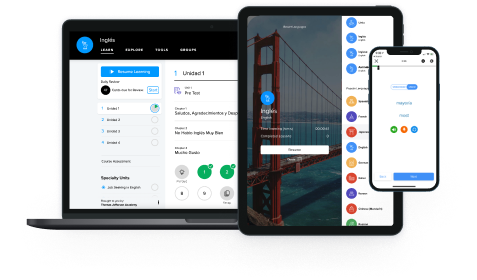A few very common verbs are used in the simple past even in spoken German: sein(to be), haben(to have), kommen(to come), gehen(to go), wissen(to know), finden(to have an opinion) and the German modal verbs.

The simple past in German is used to talk about past events, mainly in literature. This past tense is formed using only one word, unlike the more conversational perfect tense.
For example, when telling the famous story of the four intrepid animals in the picture below, someone would most likely use the simple past tense to say…
Sie gingen nach Bremen.
They went to Bremen.

In this post, we’ll discuss how to form the simple past and when you might want to use this tense as opposed to the perfect tense. Let’s get started!
When to use the simple past vs. perfect tense in German?
The German simple past and perfect tense are both used to discuss past events and are most often translated the same way. For example:
- simple past tense
Ich ging in den Wald.
I went into the forest.
- perfect tense
Ich bin in den Wald gegangen.
I went into the forest.
However, though these two tenses share a meaning they are quite different in style, so we’ll use them in different contexts:
Expect to see simple past in literary language or narrative writing (e.g. fiction, non-fiction, and other print media). This tense can be used when speaking out loud, but it’s usually used in formal or pre-written speech, like in the theater.
To illustrate, here is a quote from Die Leiden des jungen Werther(The Sorrows of Young Werther) by famous 18th century author, Johann Wolfgang von Goethe:
simple past“Letzthin kam ich zum Brunnen und fand ein junges Dienstmädchen, das ihr Gefäß auf die unterste Treppe gesetzt hatte und sich umsah, ob keine Kamerädin kommen wollte, ihr es auf den Kopf zu helfen.”
“The other day, I came to the fountain and found a young servant girl who had put her vessel on the lowest step and looked around to see whether no friend wanted to come to help her put it on her head.”
Use the perfect tense when speaking or writing informally (e.g. personal emails, text messages) or in writing that reflects the spoken language (e.g. reported speech and quoted speech).
perfect tense“Hallo Oma, ich bin gestern in Berlin gegangen.”
“Hi grandma, I arrived in Berlin yesterday.”
So, you can expect to hear and use the perfect tense in colloquial situations, but might see the simple past when reading a book or newspaper article.
Exception!
How to form the simple past in German?
The rules you’ll follow to form the simple past in German depend on the ’s class. German has three verb classes:
regular / “weak” verbs → add endings
irregular / “strong” verbs → change the
mixed class verbs → some endings, some stem changes
Each verb class forms the simple past slightly differently. Let’s first see how to form the simple past with each verb class and then we will move on to see how these forms change depending on who does the action, that is how to conjugate the simple past verbs.
How to form the simple past of regular verbs in German?
Regular verbs form the simple past by adding the past tense marker -te-. So, to form the simple past of a regular verb, follow this recipe:
Start out with the infinitive:
suchen(to look for)
holen(to get)
Remove -en to get the the verb stem:
such-
hol-
Add the past tense marker -te- to form the regular simple past:
suchte(looked for)
holte(got)
For example:
Die Mutter suchte einen Korb und Rotkäppchen holte den Kuchen.
The mother looked for a basket and Little Red Riding Hood got the cake.
How to form the simple past of irregular verbs in German?
In the simple past, irregular verbs aren’t formed using -te-, but instead have a change in the verb stem that must be memorized. For example:
gehen(to go) → ging-(went)
fressen(to devour) → fraß-(devoured)
In a sentence:
Der Wolf ging zum Haus und fraß die Großmutter.
The wolf went to the house and devoured the grandmother.
How to form the simple past of mixed class verbs in German?
Mixed class verbs are trying to trick you! They are both like regular and irregular verbs: they add the past tense marker -te- AND change the verb stem. Check it out:
Memorize the mixed class simple past stem:
rennen(to run) → rann-
können(to be able) → konn-
Add -te-:
rannte(ran)
konnte(could)
In a sentence:
Der Wolf rannte so schnell er konnte.
The wolf ran as fast it could.
There aren’t many mixed class verbs, especially ones that are used in everyday speech. Check out this list of the most common mixed class verbs in the simple past to see the most important ones to memorize. One important group of mixed class verbs are the German modal verbs.
Tip
Memorizing irregular and mixed class simple past forms is easy with these handy tricks:
Sort the verbs according to stem vowel and memorize them in groups. For example:
trinken, trank(drink, drank)
singen, sang(sing, sang)
English can often help: recall whether a verb is irregular in English. In many cases, the parallel word in German is also irregular.
Sounds a bit silly, but really works: chant them out loud! Even better, consider chanting all the and include irregular participles as well:
gehen, ging, gegangen(go, went, gone)
sehen, sah, gesehen(see, saw, seen)
Make it fun! Chant with different voices: very solemn 😐, super happy 😃, or so sad 😢!
How to conjugate simple past verbs in German?
To conjugate verbs in the simple past, you’ll take the simple past form we created above and add conjugation endings, which with the of the verb. We use the same conjugation endings for regular verbs, irregular verbs, and mixed class verbs.
You will probably notice that these endings are old acquaintances as they are the same as the present tense endings, with two exceptions: the ich form and er/sie/es form add no ending at all.
Subject pronoun | Simple Past Endings | Examples* |
|---|---|---|
ich(I) | no ending | suchte_ging_rannte_ |
du(you sg.) | -st | suchtestgingstranntest |
er(he)sie(she)es(it) | no ending | suchte_ging_rannte_ |
wir(we) | -(e)n | suchtengingenrannten |
ihr(you pl.) | -t | suchtetgingtranntet |
sie(they)Sie(you fml.) | -(e)n | suchtengingenrannten |
What is the word order in simple past clauses in German?
Simple past word order is just like present tense word order. For example, yes/no-questions are formed by bringing the verb to the start of the clause:
Sah der Jäger den Wolf?
Did the hunter see the wolf?
Negations of simple past clauses are formed with nicht:
Rotkäppchen erkannte den Wolf nicht.
Rotkäppchen did not recognize the wolf.
You can learn more about how to form clauses in our posts on German word order and German negation.
Summary
In this post, we discussed:
Usually, the simple past is the more formal and literary sibling of the perfect tense and is rarely used in colloquial speech. With some verbs, though, the simple past is still common in colloquial speech.
Different verb classes form the simple past differently:
Regular verbs follow a rule when forming the simple past: add -te.
The simple past of irregular verbs must be memorized.
The simple past of mixed class verbs must also be memorized, but you’ll also add -te.
The conjugation endings of simple past verbs is very similar to that of present tense verbs, except there is no ending in the ich(I) form or the er, sie, es(he, she, it) form.
Ready to study? Check out our list with the most common German simple past forms or get practicing using our German simple past exercises. Happy learning!
